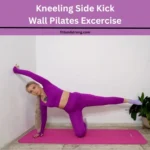In exploring the difference between Pilates and Yoga, it’s clear both enhance fitness and relaxation. While Yoga focuses on flexibility and mindfulness, Pilates emphasizes strengthening and toning.
They each offer unique benefits, making one or the other a better fit depending on personal goals. For instance, Pilates can be great for core development, whereas Yoga might be a better fit for those seeking inner peace and balance.
If you want a complete combination of yoga and Pilates, then follow the Free 21-day Pilates Workout.
Check this quick overview which highlights their key differences, yet both remain excellent choices for holistic wellbeing:
Why are Pilates And Yoga Different
The main difference between Pilates and Yoga lies in their approach to body control and flexibility. While Yoga emphasizes flexibility and working with broad muscle groups, Pilates focuses on muscle toning and core strength.
In Yoga classes, practitioners engage in flowing through different poses like warrior pose, cobra, tree pose, and downward dog, using body weight as resistance. This practice enhances balance and spirituality.
Pilates, in contrast, is more fast-paced and concentrates on body control through precise movements. It aims to build endurance and strength, focusing less on spirituality. Learn more about Pilates How Pilates Changed My Body, Life and Feeling.
Yoga also involves mindfulness and deep breathing, integral to each class. Different types of yoga maintain the standard practice of holding poses and flowing through multiple movements.
Additionally, Yoga employs the concept of chakras, the seven energy points in the body, as a major principle, further distinguishing it from Pilates.
What is Yoga
Yoga, an ancient spiritual practice rooted in India, has evolved over 5,000 years. It’s not just about physical poses or asanas; yoga integrates the mind, body, and spirit to achieve balance and wellness. This practice is deeply connected to the chakras, seven energy points in the body, aiding in resolving physical and mental issues.

In the United States, yoga has gained immense popularity, as revealed by a 2017 survey where one in seven adults reported practicing it in the preceding year. 94% of these practitioners focus on yoga for its benefits in enhancing overall wellness. Yoga is often associated with mindfulness and is sometimes referred to as meditative movement.
Hatha yoga, known for its slow-paced nature, is particularly suited for beginners, while other forms may feature faster-paced and more demanding poses. Yoga instructors often modify these poses to better suit the needs of their students, showcasing the adaptable and inclusive nature of yoga.
The overall purpose of yoga, consistent across its new styles, is the holistic connection of mind, body, and spirit. Each style, with its unique characteristics, contributes to this unified goal. The practice has continuously evolved, blending ancient elements with modern interpretations.
Yoga’s ability to improve both physical and mental health through its various forms makes it a comprehensive fitness strategy. From its spiritual roots in India, yoga has become a global phenomenon, signifying strength, awareness, and the power of internal connection.
What is Pilates
Pilates, a low-impact exercise distinct from yoga, originated with Joseph Pilates, a sickly child from Germany in 1883. He developed this discipline to improve health, blending insights from martial arts and other mind-body disciplines.
During the First World War, Joseph Pilates worked with injured soldiers, refining his method to aid in rehabilitation. After the war, he moved to New York City, where his exercises gained popularity among dancers, actors, and athletes for enhancing strength and flexibility.
Pilates focuses on stabilizing the core and involves a series of range-of-motion exercises. It can be practiced on a mat or with specialized machines in Pilates studios. This method, although sharing some similarities with yoga, stands out due to its unique approach to movement and posture.

In the 1900s, Joseph Pilates developed Contrology, a comprehensive system that aims to correct muscular imbalances and enhance stability and flexibility. This form of exercise, which eventually became known as Pilates, incorporates well-defined movements that align the spine.
Pilates blends elements of calisthenics, yoga, and ballet, placing emphasis on mind control over the body. The practice is founded on six key principles: breathing, centring, concentration, control, flow, and precision, making it a holistic approach to physical wellness.
If you want complete information about Pilates class, then read this post “ How Much Does Club Pilates Cost “
How Yoga and Pilates Differ in Benefits | Chart
Yoga Benefits
Yoga offers diverse benefits, particularly for those with specific conditions where certain poses may need modification. It’s a boon for women during pregnancy, with doctor’s approval, enhancing health without the risk of high-impact exercise.
However, care is necessary to modify positions and avoid injuries, like sprains and strains in the knee and lower leg. Advanced positions and techniques, such as headstands, lotus, and forceful breathing, can lead to issues like compression fractures in the spine, especially in individuals with glaucoma or high eye pressure.
Therefore, avoiding head-down poses and learning from a certified instructor is crucial for health and safety.
Pilates Benefits
Contrastingly, Pilates is recognized for its safety in rehabilitating joint and spinal injuries, making it a preferred choice for reconnecting with one’s body and enhancing spatial awareness.
Notably, studies have shown that Pilates may aid in weight control and serve as a valuable tool for physical rehabilitation. In a review of 23 studies, Pilates was found to reduce pain and disability in various conditions, including back pain, neck pain, scoliosis, and multiple sclerosis.
While Pilates is not classified as an aerobic exercise, it effectively reduces stress, indirectly benefiting the heart. It is generally safe for pregnant women, seniors, and children, with beginners advised to start under the guidance of a certified Pilates instructor to ensure safety and effectiveness.
Pilates and Yoga Benefits: Chart/Table
With this benefits comparison table of yoga and pilates, you can easily find out how pilates is different from yoga:
| Benefits | Yoga (✓ or ✗) | Pilates (✓ or ✗) |
|---|---|---|
| Increased Flexibility | ✓ | ✓ |
| Strength and Endurance | ✓ | ✓ |
| Balance and Stability | ✓ | ✓ |
| Improved Breathing | ✓ | ✗ |
| Enhanced Posture | ✓ | ✓ |
| Body Awareness | ✓ | ✓ |
| Stress and Anxiety Reduction | ✓ | ✓ |
| Improved Sleep | ✓ | ✗ |
| Eases Low-Back and Neck Pain | ✓ | ✓ |
| Weight Control | ✓ | ✓ |
| Eases Tension Headaches | ✓ | ✗ |
| Alleviates Knee Osteoarthritis Pain | ✓ | ✗ |
| Menopause Symptom Relief | ✓ | ✗ |
| Spine Strength and Core Stability | ✗ | ✓ |
| Increased Lung Capacity | ✗ | ✓ |
| Increased Bone Density | ✗ | ✓ |
| Rehabilitation for Joint and Spinal Injuries | ✗ | ✓ |
| Spatial Awareness | ✗ | ✓ |
| Reduces Pain and Disability in Various Conditions | ✗ | ✓ |
| Heart Health Benefits | ✗ | ✓ |
| Safe for Diverse Groups (Pregnant, Seniors, Children) | ✗ | ✓ |
| Physical Rehabilitation | ✗ | ✓ |
| Total Unique Benefits | 14 | 16 |
Through this comparison, it becomes evident that while both yoga and Pilates offer significant health benefits, they cater to different needs and priorities.
Yoga focuses on holistic well-being, encompassing physical and mental aspects, whereas Pilates emphasizes precise body movements for physical rehabilitation and conditioning.
The Mental Benefits of Yoga and Pilates
Research by MindBody shows that 70 per cent of individuals practicing yoga or Pilates experience stress relief. These practices incorporate breathing techniques to combat anxiety and feelings of stress, enhancing overall wellbeing.

Both yoga and Pilates teach students to align the body, mind, and spirit. This alignment is crucial in managing stress and fostering a sense of self-care and focus.
As a holistic system, yoga is deeply concerned with not just the body but also the mind and spirit. According to Simpson, it integrates physical practice with meditation, allowing an opportunity to slow down in our fast-paced lives.
Bertali notes that yoga’s physical postures, along with breath work and meditation, have a balancing effect on the nervous system. This balance is achieved through deeper breathing and detoxifying practices.
These practices involve twists and turns in postures, promoting hydration and a fresh blood supply to organs and joints. They keep practitioners anchored in the moment, away from daily distractions, creating mental space.
The Rehabilitation Benefits of Yoga and Pilates
Yoga and Pilates are often recommended by doctors and sports therapists for rehabilitation post-injury, especially to complement various high-impact sports. Both practices offer unique approaches to recovery.
Bertali emphasizes that their slower, controlled practices are ideal for addressing specific injuries through targeted postures. This makes them suitable for people recovering from depression or trauma, helping to re-balance hormones.
Simpson suggests that while Pilates may be more beneficial for recovery, yoga can prevent sports injuries and ailments. Pilates focuses on targeted movements and adaptable solutions for injury or chronic pain.
Yoga, with its restorative effect on the body and mind, aids in stretching muscles for those who play sports, run, or cycle. Yin yoga, in particular, supports training and recovery.
Both yoga and Pilates assist in improving performance, offering support and the ability to slow down and stretch into targeted areas, crucial for holistic rehabilitation.
Mind-Body Harmony Through Pilates and Yoga Practices
Pilates and Yoga, gaining traction in recent years, are effective forms of exercise that deeply emphasise the mind-body connection. These practices offer unique paths to wellness and self-awareness.
In Pilates, practitioners engage in precise control, executing graceful movements with precise execution and postural alignment. This focus on control and alignment fosters a deep connection with the body.
Yoga offers a more meditative experience, combining robust physical stretches with breathing exercises. This blend helps stimulate the release of both mental and physical toxins from the body, enhancing overall well-being.
Both styles of exercise enable practitioners to stay fit, find balance and harmony in their bodies, and spark joy in their lives. They cater to different aspects of wellness, offering varied paths to holistic health.
The Timeless Journey of Yoga and the Rise of Pilates
Yoga and Pilates, although both practice styles, have been around for quite a while, each with vastly different origins. Yoga, deeply rooted in spirituality, originated centuries ago, evolving from a spiritual practice to a form of exercise over the years.
Joseph Pilates developed Pilates in the early 20th century, marking a distinct shift in the world of fitness. Unlike yoga, Pilates focuses on muscular strength and toning abilities through controlled movements.
Both approaches have become popular worldwide, serving as complementary methods of exercise or as stand-alone practices. Yoga encourages awareness and a connection between body and mind, integrating breathing and movement.
Pilates focuses on physical conditioning, enhancing the body’s strength and form. Its emphasis on precision has made it a popular choice for those seeking focused physical training.
Ultimately, both offer incredible benefits to physical health and mental clarity, making them popular choices. Whether alone or combined, they form a powerful system for overall wellness.
Yoga’s Simplicity vs Pilates’ Equipment-Centric Approach
While both Pilates and yoga are popular forms of exercise that enhance strength and relaxation, they differ in approach and execution. These distinct differences shape the experiences they offer.
Yoga is known for its simplicity, often practiced without many props. It emphasizes physical balance, integrating the body and mind through movements and breath. Its flexibility appeals to many.

In contrast, Pilates typically involves various equipment like reformers, mats, and benches. This equipment-centric approach allows for more targeted exercises, focusing on precise muscle control and strength building.
Ultimately, the choice between yoga and Pilates depends on what you’re looking for. Whether it’s the unique benefits of yoga’s simplicity or Pilates’ structured equipment use, both offer paths to wellness.
Discovering the Unique Movement Styles of Yoga and Pilates
Pilates and yoga are both forms of exercise that emphasize inner strength and physical health. Despite sharing common themes, they each have distinct differences in their approach to movement and fitness.
Pilates focuses on controlled movements and precision in each movement, often involving a few repetitions. Breath work is a major component, adding power to Pilates movements, which can be both difficult and complex.
Conversely, yoga emphasizes flowing postures and sequences that transition effortlessly from one pose to another. Posture accuracy is essential in yoga to achieve maximum benefits from the practice.
Both Pilates and yoga have different goals in mind when practiced. While Pilates focuses on muscle control and strength, yoga seeks to balance the body and mind through fluid movements.
Ultimately, each offers unique benefits for everyone who works out. Whether you’re seeking the disciplined precision of Pilates or the fluidity of yoga, both cater to diverse fitness needs and preferences.
Enhancing Balance and Strength – Yoga and Pilates Unite
Pilates and yoga, both ancient disciplines, have been enhancing flexibility, strength, and balance for centuries. These practices focus on harmonizing the body and mind, offering unique benefits.
Pilates utilizes specialized equipment like reformers to target major muscle groups, ensuring an even playing field in strength and agility. It’s known for its precision in movement and breath control.
Meanwhile, yoga focuses on flowing postures without the need for props, emphasizing fluidity and mind-body awareness. It opens up a wide range of motion, challenging the body differently.
Both Pilates and yoga offer distinct options to boost confidence and energy. Whether you prefer one over the other depends on your personal preferences and goals.
Ultimately, both are excellent ways to improve flexibility, strength, and balance. Trying both can help you discover which works best for your fitness journey.
Which is better: Yoga or Pilates?
Deciding between Yoga and Pilates depends on individual preferences and goals. Both are low impact exercises known to increase strength and flexibility. Your choice should align with your personal health objectives.
If you’re recovering from an injury, Pilates might be a better choice due to its focused physical rehabilitation. However, if you aim to be super flexible, you may find more progress with Yoga.
The spiritual side of Yoga appeals to many, while others prefer Pilates for its intense physical workout. Ultimately, there’s something for everyone in both practices. It’s advisable to try both and see which resonates with you.
You don’t have to pick one over the other; Pilates vs Yoga isn’t a strict dichotomy. Many incorporate both into their training. Start by taking a class, focusing more on enjoying the movement rather than doing it ‘right.’
Classes can be easy or challenging, and exercises can be modified. Listen to your body, and don’t hesitate to rest if an exercise doesn’t work for you.
Final Words: Which Should You Do?
Determining whether Pilates or yoga is better suited for you can be difficult. If your goal is to increase strength and flexibility, Pilates might be the right choice. For those seeking overall wellness, yoga could be more appropriate.
Both Pilates and yoga offer unique benefits, and the choice often depends on the skills and qualifications of available instructors and the specific classes you have access to. It’s about finding the right fit for you.
While yoga is appropriate for men and women, some men may feel they aren’t flexible enough for it. However, both genders can greatly benefit from practicing yoga, with poses having different effects on each.
Pilates, though sometimes facing a problem attracting males, was invented by a man, Joseph Pilates, who developed its principles while working with male soldiers. This history may encourage more men to try Pilates






yandanxvurulmus.X5Rul4p5UWcg